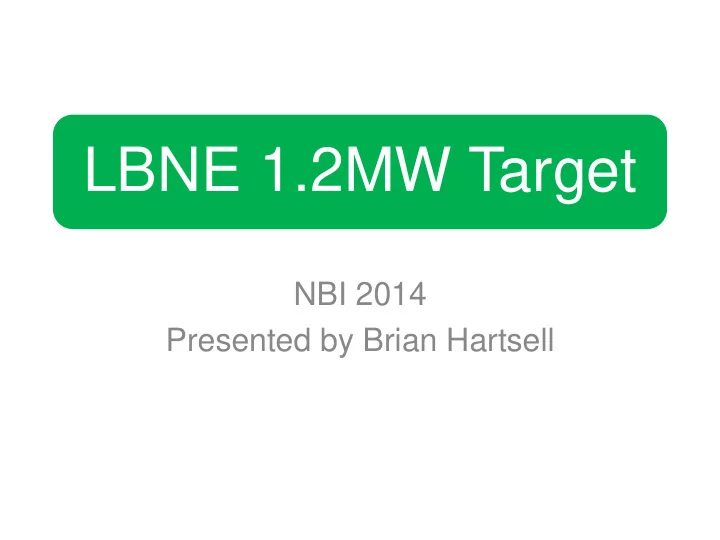

LBNE 1.2MW Target NBI 2014 Presented by Brian Hartsell
LBNE Target - Introduction Target • Relevant parameters for 1.2MW target operation: – 120 GeV: 7.5e13 ppp, 1.2 sec cycle time – 80 GeV: 7.5e13 ppp, 0.8 sec cycle time 2
First pass - scaling up the NuMI target • Based on the original NuMI LE target design from IHEP. • Increase the beam sigma from 1.3mm to 1.7mm to give the same peak proton flux (700kW NOvA to 1200kW LBNE) • Simply scaling up the target results in temperatures at the water line interface that are too large (>150C) 3
LBNE Target - Geometry 4
Energy Deposition • Analysis provided by Diane Reitzner • 1 & 3 sigma energy deposition peaks at fin 8 • Total heat load: 12kW – ~11kW to graphite, ~1kW to Ti/Water 5
Fin 8 Stress/Temperature • Fin 8 chosen due to highest temperature and largest temperature gradient. Fairly simple model of one pulse at room temperature, warm to steady state, another pulse, and cooling to room temperature. • Maximum Von-Mises stress is ~10MPa while yield is near 80 MPa. 6
Stress Components • Generated these plots in response to the discussion yesterday afternoon. • X component of stress 7
Stress Components • Y component of stress 8
Stress Components • Z component of stress 9
Off-Center Pulse Effects Find expected stress from a single pulse of an off-center beam in the X direction Beam Offset Thermal Structural VM Stress 10
Off-Center Pulse Effects • Modeled the steady-state deformation of sustained off-center pulses. • Deformations are exaggerated by a factor of 200 for visual effect. 1mm offset 2mm offset 0.19 mm deformation 0.32 mm deformation 11
Ti Water Lines • Grade 2 Titanium water lines are chosen based on a report by the RAL group (O. Caretta, T. Davenne, C.J. Densham). Originally this model was intended to evaluate the water hammer effect from the beam impact. • Most interesting part of this model wasn’t the water hammer, but the stress between the fins. Stress concentration introduced by the sharp transition between fin and water line – safety factor of 2.4 to fatigue as modeled 12
Ti Water Lines • Water line model was refined to include a 0.005” fillet introduced by the brazing process for a more realistic evaluation of the safety factor. • Increased fatigue safety factor to 3.2. 13
Target Canister • The target canister and downstream window will be constructed from Beryllium for less heading due to the beam interactions. • Look at temperatures and stresses in this canister. • Cooling only provided by water loop on the target and the connection to the base. • Resulting temperatures (~225C) and stresses (27 MPa) are low. 14
Safety Factors Rollup Safety Location Material Stress Criteria Factor Worst Case Graphite 10.5 MPa UTS - 80MPa 7.6 Fin Fin, Off- Center Pulse Graphite 12.7 MPa UTS - 80MPa 6.3 Water Line, Titanium M-96MPa, Goodman @ 90C 3.2 Pulsed Grade 2 Alt-23MPa (mean temp) Yield - 218 MPa @ Can Beryllium 25.9 Mpa 8.4 185C Yield - 218 MPa @ Window Beryllium 27.2 MPa 8.0 185C 15
Target DPA 16
Conclusions and To-Do • A workable design has been presented with acceptable safety factors • 80 GeV FEA work still to be done. 17
Recommend
More recommend